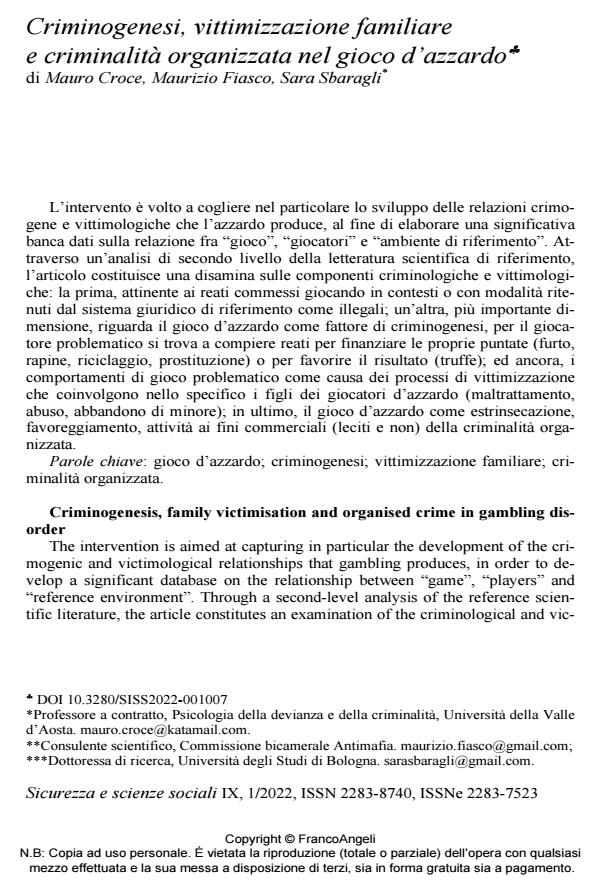Criminogenesi, vittimizzazione familiare e criminalità organizzata nel gioco d’azzardo
Titolo Rivista SICUREZZA E SCIENZE SOCIALI
Autori/Curatori Mauro Croce, Maurizio Fiasco, Sara Sbaragli
Anno di pubblicazione 2022 Fascicolo 2022/1
Lingua Italiano Numero pagine 18 P. 73-90 Dimensione file 257 KB
DOI 10.3280/SISS2022-001007
Il DOI è il codice a barre della proprietà intellettuale: per saperne di più
clicca qui
Qui sotto puoi vedere in anteprima la prima pagina di questo articolo.
Se questo articolo ti interessa, lo puoi acquistare (e scaricare in formato pdf) seguendo le facili indicazioni per acquistare il download credit. Acquista Download Credits per scaricare questo Articolo in formato PDF

FrancoAngeli è membro della Publishers International Linking Association, Inc (PILA)associazione indipendente e non profit per facilitare (attraverso i servizi tecnologici implementati da CrossRef.org) l’accesso degli studiosi ai contenuti digitali nelle pubblicazioni professionali e scientifiche
L’intervento è volto a cogliere nel particolare lo sviluppo delle relazioni crimo-gene e vittimologiche che l’azzardo produce, al fine di elaborare una significativa banca dati sulla relazione fra "gioco", "giocatori" e "ambiente di riferimento". Attraverso un’analisi di secondo livello della letteratura scientifica di riferimento, l’articolo costituisce una disamina sulle componenti criminologiche e vittimologiche: la prima, attinente ai reati commessi giocando in contesti o con modalità ritenuti dal sistema giuridico di riferimento come illegali; un’altra, più importante di-mensione, riguarda il gioco d’azzardo come fattore di criminogenesi, per il giocatore problematico si trova a compiere reati per finanziare le proprie puntate (furto, rapine, riciclaggio, prostituzione) o per favorire il risultato (truffe); ed ancora, i comportamenti di gioco problematico come causa dei processi di vittimizzazione che coinvolgono nello specifico i figli dei giocatori d’azzardo (maltrattamento, abuso, abbandono di minore); in ultimo, il gioco d’azzardo come estrinsecazione, favoreggiamento, attività ai fini commerciali (leciti e non) della criminalità organizzata.
Parole chiave:gioco d’azzardo; criminogenesi; vittimizzazione familiare; criminalità organizzata.
- Il gioco d’azzardo: una prospettiva multidisciplinare Mauro Croce, pp.27 (ISBN:979-12-215-0444-6)
Mauro Croce, Maurizio Fiasco, Sara Sbaragli, Criminogenesi, vittimizzazione familiare e criminalità organizzata nel gioco d’azzardo in "SICUREZZA E SCIENZE SOCIALI" 1/2022, pp 73-90, DOI: 10.3280/SISS2022-001007